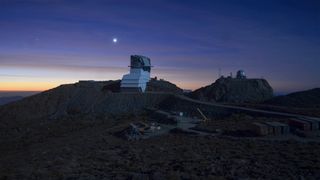Rubin Observatory and Google will store astronomy data in the cloud

The new Vera C. Rubin Observatory in Chile has announced a three-year agreement with Google to host data from astronomy observations in the cloud.
Rubin and Google said that the collaboration, made public Dec. 9, would bring in a new generation of "large-scale scientific computing" projects that can be shared worldwide with Internet services.
Google will host Rubin's Interim Data Facility (IDF) that will collect preliminary data until the observatory becomes fully operational in 2023. The data will eventually be available to hundreds of scientists ahead of the prime observing phase of Rubin, known as the Legacy Survey of Space and Time, or LSST. (The observatory itself was previously called LSST, short for "Large Synoptic Survey Telescope," before it was renamed earlier this year.)
Related: 3,200 megapixels! The camera heart of future Vera Rubin Observatory snaps record-breaking 1st photo
"By using an established and trusted cloud infrastructure, we've been able to stay on track … to ensure we'll be ready to deliver high-impact science to our community when the telescope, camera, and data system are ready," Bob Blum, acting Rubin Observatory operations director, said in an emailed Google statement. "LSST is the one experiment that gathers data on the solar system, variable and exploding stars, the stars that make up our Milky Way galaxy, and the expansion of the universe itself."
The interim data set will be so large that users will use a browser-based science platform to use the information, avoiding the need for downloads, Google said in the statement. The LSST is expected to generate 500 petabytes (roughly 500,000 terabytes) of information, and the storage space of the interim data set was not released.
"The advancements we're seeing in astronomy point to the growing appetite for data that can only be supported by the cloud's scale and speed," Mike Daniels, vice president of Google Cloud's global public sector, said in the same statement. "By collaborating with Google Cloud, Rubin Observatory can build in more flexibility for the rising demand of astronomical data, while taking advantage of low-cost cloud data storage. This means Rubin Observatory can use more funds toward discoveries, instead of IT."
Get the Space.com Newsletter
Breaking space news, the latest updates on rocket launches, skywatching events and more!
Related: A 'tsunami' for astrophysics: New Gaia data reveals the best map of our galaxy yet
Members of the science community can start accessing the interim data set in late 2021. Rubin is funded through the U.S. National Science Foundation, the U.S. Department of Energy, and with private funding raised by the LSST Corporation.
Follow Elizabeth Howell on Twitter @howellspace. Follow us on Twitter @Spacedotcom and on Facebook.
Join our Space Forums to keep talking space on the latest missions, night sky and more! And if you have a news tip, correction or comment, let us know at: community@space.com.

Elizabeth Howell (she/her), Ph.D., is a staff writer in the spaceflight channel since 2022 covering diversity, education and gaming as well. She was contributing writer for Space.com for 10 years before joining full-time. Elizabeth's reporting includes multiple exclusives with the White House and Office of the Vice-President of the United States, an exclusive conversation with aspiring space tourist (and NSYNC bassist) Lance Bass, speaking several times with the International Space Station, witnessing five human spaceflight launches on two continents, flying parabolic, working inside a spacesuit, and participating in a simulated Mars mission. Her latest book, "Why Am I Taller?", is co-written with astronaut Dave Williams. Elizabeth holds a Ph.D. and M.Sc. in Space Studies from the University of North Dakota, a Bachelor of Journalism from Canada's Carleton University and a Bachelor of History from Canada's Athabasca University. Elizabeth is also a post-secondary instructor in communications and science at several institutions since 2015; her experience includes developing and teaching an astronomy course at Canada's Algonquin College (with Indigenous content as well) to more than 1,000 students since 2020. Elizabeth first got interested in space after watching the movie Apollo 13 in 1996, and still wants to be an astronaut someday. Mastodon: https://qoto.org/@howellspace
Most Popular

